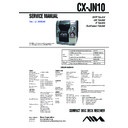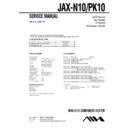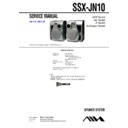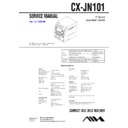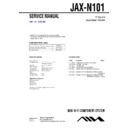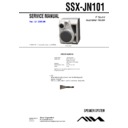Sony CX-JN10 / JAX-N10 Service Manual ▷ View online
SERVICE MANUAL
TUNER
FM tuning range
87.5 MHz to 108 MHz
FM
AEP, UK models:
Except AEP, UK models:
AEP, UK models:
Except AEP, UK models:
usable sensitivity (IHF)
16.8 dBf
FM antenna terminal
75 ohms (unbalanced)
AM
AEP, UK, E, EA, TW models:
E51 model:
AEP, UK, E, EA, TW models:
E51 model:
tuning range
531 kHz to 1602 kHz
AM usable sensitivity
350
µV/m
SP, AUS models:
530 kHz to 1710 kHz (10 kHz step)
531 kHz to 1602 kHz (9 kHz step)
AM antenna
Loop antenna
AMPLIFIER
Power
AEP, UK models:
AEP, UK models:
Except AEP, UK models:
output
Rated: 12 W + 12 W (6 ohms, T.H.D.
1 %, 1 kHz/DIN 45500)
Reference: 15 W + 15 W (6 ohms,
T.H.D. 10 %, 1 kHz/DIN 45324)
MUSIC POWER: 27 W +27 W
1 %, 1 kHz/DIN 45500)
Reference: 15 W + 15 W (6 ohms,
T.H.D. 10 %, 1 kHz/DIN 45324)
MUSIC POWER: 27 W +27 W
CASSETTE DECK
Track format
4 tracks, 2 channels stereo
Frequency response
50 Hz – 8 kHz
Recording system
AC bias
Heads
Deck A: playback x 1
Deck B: recording/playback x 1,
erase x 1
Deck B: recording/playback x 1,
erase x 1
CD PLAYER
Laser
Semiconductor laser
(
(
λ = 780 nm)
Emission duration:
continuous
continuous
D/A converter
1 bit dual
Signal-to-noise ratio
85 dB (1 kHz, 0 dB)
Harmonic distortion
0.05 % (1 kHz, 0 dB)
AEP, UK models:
AEP, UK models:
Except AEP, UK models:
Power consumption
40 W
Power consumption
With ECO mode on: 0.25 W
in standby mode
With ECO mode off: 15 W
Dimensions (W x H x D)
280 x 330 x 392.5 mm
Weight
6.1 kg
Specifications and external appearance are subject to change
without notice.
without notice.
13.2 dBf
530 kHz to 1710 kHz (10 kHz step)
531 kHz to 1710 kHz (9 kHz step)
531 kHz to 1710 kHz (9 kHz step)
Rated: 36 W + 36 W (1 kHz, T.H.D. 1
%, 6 ohms)
Reference: 45 W + 45 W (1 kHz,
T.H.D. 10 %, 6 ohms)
%, 6 ohms)
Reference: 45 W + 45 W (1 kHz,
T.H.D. 10 %, 6 ohms)
74 W
E, EA, SP, TW, AUS models: 6.8 kg
E51 model:
6.7 kg
Total harmonic distortion
0.08 % (6 W, 1 kHz, 6 ohms, DIN
AUDIO)
AUDIO)
(Except AEP, UK models)
Input
VIDEO/AUX: 400 mV
Outputs
SPEAKER:
MIC: 1.7 mV (10k ohms)
6 ohms or more
PHONES: 32 ohms or more
COPYRIGHT
Check copyright laws relevant to recordings from discs, tuner
or tape for the country where the unit is to be used.
Check copyright laws relevant to recordings from discs, tuner
or tape for the country where the unit is to be used.
GENERAL
Power
AEP, UK models:
E, E51, SP models:
AEP, UK models:
E, E51, SP models:
TW model:
requirements
230 V AC, 50/60 Hz
110
120 V AC, 50 Hz/60 Hz
- 120V / 220 - 240V AC
(Switchable), 50 Hz/60 Hz
EA model:
120 - 127V / 220 V AC
(Switchable), 50 Hz/60 Hz
(Switchable), 50 Hz/60 Hz
AUS model:
240 V AC, 50 Hz/60 Hz
COMPACT DISC DECK RECEIVER
AEP Model
UK Model
E Model
Australian Model
CX-JN10
Ver. 1.2 2005.05
9-877-593-03
Sony Corporation
2005E05-1
Personal Audio Group
© 2005.05
Published by Sony Engineering Corporation
SPECIFICATIONS
CX-JN10 is the tuner, amplifier, cassette deck
and CD player section in JAX-N10/PK10.
and CD player section in JAX-N10/PK10.
Model Name Using Similar Mechanism
CX-JN1
CD Mechanism Type
CDM74S-K6BD72
CD
Base Unit Name
BU-K6BD72
Section
Optical Pick-up Block Name
KSM-213DCP
Optical Pick-up Name
KSS-213D
Tape deck
Model Name Using Similar Mechanism
CX-JN1
Section
Tape Transport Mechanism type
CWM43FF13
• Abbreviation
AUS : Australian model
E51 : Chilean and Peruvian models
EA : Saudi Arabia model
SP
E51 : Chilean and Peruvian models
EA : Saudi Arabia model
SP
: Singapore model
TW : Taiwan model
CX-JN10
2
Notes on chip component replacement
• Never reuse a disconnected chip component.
• Notice that the minus side of a tantalum capacitor may be dam-
aged by heat.
Flexible Circuit Board Repairing
• Keep the temperature of the soldering iron around 270 °C dur-
ing repairing.
• Do not touch the soldering iron on the same conductor of the
circuit board (within 3 times).
• Be careful not to apply force on the conductor when soldering
or unsoldering.
CAUTION
Use of controls or adjustments or performance of procedures
other than those specified herein may result in hazardous ra-
diation exposure.
other than those specified herein may result in hazardous ra-
diation exposure.
SAFETY-RELATED COMPONENT WARNING!!
COMPONENTS IDENTIFIED BY MARK
0
OR DOTTED
LINE WITH MARK
0
ON THE SCHEMATIC DIAGRAMS
AND IN THE PARTS LIST ARE CRITICAL TO SAFE
OPERATION. REPLACE THESE COMPONENTS WITH
SONY PARTS WHOSE PART NUMBERS APPEAR AS
SHOWN IN THIS MANUAL OR IN SUPPLEMENTS PUB-
LISHED BY SONY.
OPERATION. REPLACE THESE COMPONENTS WITH
SONY PARTS WHOSE PART NUMBERS APPEAR AS
SHOWN IN THIS MANUAL OR IN SUPPLEMENTS PUB-
LISHED BY SONY.
This appliance is classified as
a CLASS 1 LASER product.
The CLASS 1 LASER
PRODUCT MARKING is
located on the rear exterior.
a CLASS 1 LASER product.
The CLASS 1 LASER
PRODUCT MARKING is
located on the rear exterior.
CX-JN10
3
TABLE OF CONTENTS
1.
SERVICING NOTES
................................................
4
2.
GENERAL
Location of Controls .......................................................
7
3.
DISASSEMBLY
3-1. Disassembly Flow ...........................................................
9
3-2. Case (SIDE-L/R) ............................................................. 10
3-3. Case (Top) ....................................................................... 10
3-4. Tray Panel ........................................................................ 11
3-5. CD Mechanism Deck (CDM74S-K6BD72) ................... 11
3-6. Front Panel Section ......................................................... 12
3-7. Mechanical Deck (CWM43FF13) .................................. 12
3-8. Rear Cabinet Section ...................................................... 13
3-9. PT Board, MAIN Board .................................................. 13
3-10. Table Assy ....................................................................... 14
3-11. Motor (TB) Board ........................................................... 14
3-12. Motor (LD) Board ........................................................... 15
3-13. Base Unit (BU-K6BD72) ................................................ 15
3-14. Motor Gear Assy (Sled) (M701), BD Board .................. 16
3-3. Case (Top) ....................................................................... 10
3-4. Tray Panel ........................................................................ 11
3-5. CD Mechanism Deck (CDM74S-K6BD72) ................... 11
3-6. Front Panel Section ......................................................... 12
3-7. Mechanical Deck (CWM43FF13) .................................. 12
3-8. Rear Cabinet Section ...................................................... 13
3-9. PT Board, MAIN Board .................................................. 13
3-10. Table Assy ....................................................................... 14
3-11. Motor (TB) Board ........................................................... 14
3-12. Motor (LD) Board ........................................................... 15
3-13. Base Unit (BU-K6BD72) ................................................ 15
3-14. Motor Gear Assy (Sled) (M701), BD Board .................. 16
4.
TEST MODE
.............................................................. 17
5.
ELECTRICAL ADJUSTMENTS
CD Section ...................................................................... 19
6.
DIAGRAMS
6-1. Block Diagram – CD Section – ..................................... 20
6-2. Block Diagram – TUNER/TAPE/PANEL Section – ..... 21
6-3. Block Diagram – AMP/POWER SUPPLY Section – ... 22
6-4. Note for Printed Wiring Boards and
6-2. Block Diagram – TUNER/TAPE/PANEL Section – ..... 21
6-3. Block Diagram – AMP/POWER SUPPLY Section – ... 22
6-4. Note for Printed Wiring Boards and
Schematic Diagrams ....................................................... 23
6-5. Printed Wiring Board – BD Section – ........................... 24
6-6. Schematic Diagram – BD Section – .............................. 25
6-7. Printed Wiring Boards – CHANGER Section – ............ 26
6-8. Schematic Diagram – CHANGER Section – ................ 27
6-9. Schematic Diagram – MAIN Section (1/4) – ................ 28
6-10. Schematic Diagram – MAIN Section (2/4) – ................ 29
6-11. Schematic Diagram – MAIN Section (3/4) – ................ 30
6-12. Schematic Diagram – MAIN Section (4/4) – ................ 31
6-13. Printed Wiring Board – MAIN Section – ...................... 32
6-14. Printed Wiring Board – HP Section – ........................... 33
6-15. Schematic Diagram – HP Section – .............................. 33
6-16. Printed Wiring Board – PANEL Section – .................... 34
6-17. Schematic Diagram – PANEL Section – ....................... 35
6-18. Printed Wiring Boards – KEY Section – ....................... 36
6-19. Schematic Diagram – KEY Section – ........................... 37
6-20. Printed Wiring Board – PT Section –
6-6. Schematic Diagram – BD Section – .............................. 25
6-7. Printed Wiring Boards – CHANGER Section – ............ 26
6-8. Schematic Diagram – CHANGER Section – ................ 27
6-9. Schematic Diagram – MAIN Section (1/4) – ................ 28
6-10. Schematic Diagram – MAIN Section (2/4) – ................ 29
6-11. Schematic Diagram – MAIN Section (3/4) – ................ 30
6-12. Schematic Diagram – MAIN Section (4/4) – ................ 31
6-13. Printed Wiring Board – MAIN Section – ...................... 32
6-14. Printed Wiring Board – HP Section – ........................... 33
6-15. Schematic Diagram – HP Section – .............................. 33
6-16. Printed Wiring Board – PANEL Section – .................... 34
6-17. Schematic Diagram – PANEL Section – ....................... 35
6-18. Printed Wiring Boards – KEY Section – ....................... 36
6-19. Schematic Diagram – KEY Section – ........................... 37
6-20. Printed Wiring Board – PT Section –
(AEP, UK, AUS) .............................................................. 38
6-21. Schematic Diagram – PT Section –
(AEP, UK, AUS) .............................................................. 39
6-22. Printed Wiring Board – PT Section –
(E, EA, E51, SP, TW) ..................................................... 40
6-23. Schematic Diagram – PT Section –
(E, EA, E51, SP, TW) ..................................................... 41
7.
EXPLODED VIEWS
7-1. Case Section .................................................................... 47
7-2. Tape Deck Section .......................................................... 48
7-3. Panel Board Section ........................................................ 49
7-4. Key Section ..................................................................... 50
7-5. Front Cabinet Section ..................................................... 51
7-6. Chassis Section ............................................................... 52
7-7. CD Mechanism Deck Section-1
7-2. Tape Deck Section .......................................................... 48
7-3. Panel Board Section ........................................................ 49
7-4. Key Section ..................................................................... 50
7-5. Front Cabinet Section ..................................................... 51
7-6. Chassis Section ............................................................... 52
7-7. CD Mechanism Deck Section-1
(CDM74S-K6BD72) ....................................................... 53
7-8. CD Mechanism Deck Section-2
(CDM74S-K6BD72) ....................................................... 54
7-9. CD Mechanism Deck Section-3
(CDM74S-K6BD72) ....................................................... 55
7-10. Base Unit Section (BU-K6BD72) .................................. 56
8.
ELECTRICAL PARTS LIST
............................... 57
•
•
Abbreviation
AUS : Australian model
E51 : Chilean and Peruvian models
EA : Saudi Arabia model
SP
AUS : Australian model
E51 : Chilean and Peruvian models
EA : Saudi Arabia model
SP
: Singapore model
TW : Taiwan model
4
CX-JN10
SECTION 1
SERVICING NOTES
NOTES ON HANDLING THE OPTICAL PICK-UP
BLOCK OR BASE UNIT
BLOCK OR BASE UNIT
The laser diode in the optical pick-up block may suffer electro-
static break-down because of the potential difference generated
by the charged electrostatic load, etc. on clothing and the human
body.
During repair, pay attention to electrostatic break-down and also
use the procedure in the printed matter which is included in the
repair parts.
The flexible board is easily damaged and should be handled with
care.
static break-down because of the potential difference generated
by the charged electrostatic load, etc. on clothing and the human
body.
During repair, pay attention to electrostatic break-down and also
use the procedure in the printed matter which is included in the
repair parts.
The flexible board is easily damaged and should be handled with
care.
NOTES ON LASER DIODE EMISSION CHECK
The laser beam on this model is concentrated so as to be focused
on the disc reflective surface by the objective lens in the optical
pick-up block. Therefore, when checking the laser diode emis-
sion, observe from more than 30 cm away from the objective lens.
on the disc reflective surface by the objective lens in the optical
pick-up block. Therefore, when checking the laser diode emis-
sion, observe from more than 30 cm away from the objective lens.
LASER DIODE AND FOCUS SEARCH OPERATION
CHECK
CHECK
Carry out the “S curve check” in “CD section adjustment” and
check that the S curve waveforms is output three times.
check that the S curve waveforms is output three times.
•
MODEL IDENTIFICATION
– Back Panel –
MODEL
PART No.
AEP and UK models
No model number label
Taiwan model
4-248-949-2
[]
Singapore model
4-249-031-6
[]
Australian model
4-249-128-2
[]
Saudi Arabia model
4-249-129-6
[]
E model
4-249-130-8
[]
Chilean and Peruvian models
4-249-802-3
[]
PART No.
UNLEADED SOLDER
Boards requiring use of unleaded solder are printed with the lead-
free mark (LF) indicating the solder contains no lead.
(Caution: Some printed circuit boards may not come printed with
free mark (LF) indicating the solder contains no lead.
(Caution: Some printed circuit boards may not come printed with
the lead free mark due to their particular size)
: LEAD FREE MARK
Unleaded solder has the following characteristics.
• Unleaded solder melts at a temperature about 40 °C higher than
• Unleaded solder melts at a temperature about 40 °C higher than
ordinary solder.
Ordinary soldering irons can be used but the iron tip has to be
applied to the solder joint for a slightly longer time.
Soldering irons using a temperature regulator should be set to
about 350
Ordinary soldering irons can be used but the iron tip has to be
applied to the solder joint for a slightly longer time.
Soldering irons using a temperature regulator should be set to
about 350
°C.
Caution: The printed pattern (copper foil) may peel away if the
heated tip is applied for too long, so be careful!
• Strong viscosity
Unleaded solder is more viscou-s (sticky, less prone to flow)
than ordinary solder so use caution not to let solder bridges oc-
cur such as on IC pins, etc.
than ordinary solder so use caution not to let solder bridges oc-
cur such as on IC pins, etc.
• Usable with ordinary solder
It is best to use only unleaded solder but unleaded solder may
also be added to ordinary solder.
also be added to ordinary solder.
RELEASING THE DISC TRAY LOCK
The disc tray lock function for the antitheft of an demonstration
disc in the store is equipped.
disc in the store is equipped.
Releasing Procedure :
While pressing the
While pressing the
x
key, press the
OPEN/CLOSE
Z
key for 5
seconds. The message “UNLOCKED” is displayed and the tray is
unlocked.
unlocked.
Note:
When “LOCKED” is displayed, the tray lock is not released by
turning power on/off with the
turning power on/off with the
[POWER]
key.

